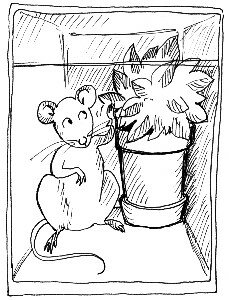STRANGE BUT TRUE- Symbiosis: Mouse keeps plants alive

Q. Put a mouse in an airtight chamber and soon it dies. Put in a plant and– not quite as fast– it dies too. But what if both are enclosed together?– Mrs. Frisby
A. This 1772 experiment by Joseph Priestley, discoverer of oxygen, proved plants need to breathe as they grow, says Guy Murchie in The Seven Mysteries of Life. The suffocation of the plant was remarkable enough at the time. Even more surprising was Priestley's discovery that enclosing a plant and animal together meant both could live!
This seeming miracle resulted from "the animal inhaling oxygen and exhaling carbon dioxide, while the plant accommodatingly did just the reverse." Out of this grew the custom of bringing plants into sickrooms, theretofore kept shuttered tightly against "harmful" outdoor air.
Q. Does embalming do as advertised and slow a body's return to dust? –C. Dracula
A. "Yes, no, and maybe," answers Kenneth Iserson in Death to Dust: What Happens to Dead Bodies? Intense embalming can slow decay for years, even centuries. But embalmers typically take short cuts, focusing more on body areas mourners will see, such as the face, neck and hands.
"Anybody seriously interested in slowing a body's decay must get a better-than-average embalming job," Iserson says. One strategy is to inform the embalmer you'll be checking up later. One guy who came back a year after his mother's entombment in a mausoleum found her body badly decomposed, in spite of earlier assurances by the embalmer.
"He sued the funeral home– and won," Iserson reports.
Q. From an evolutionary standpoint, why might it be so difficult for baseball batters to hit a good curve ball? Early humans certainly didn't have to deal with one of these back during the Stone Age. –B. Bonds
A. The human visual system just isn't equipped to track the curved course of a fast-spinning ball, whether a baseball or a soccer ball, says Queen's University, Belfast psychologist Cathy Craig in New Scientist magazine. She recalls watching Roberto Carlos score a mesmerizing goal for Brazil in 1997, when everybody felt the ball was going wide of the mark until it curved in at the last instant.
But don't overhastily blame the goalkeeper, she says. She tested experienced soccer players to see if they could follow (predict) the trajectories of balls with rapid sidespin of 600 rpm– via a virtual reality display–and they couldn't. Sidespin creates a "Magnus force," just what a baseball pitcher relies on for a curve ball. This force accelerates balls in a direction we humans are unable to process because spinning things don't occur naturally, meaning we have had little evolutionary experience with Magnus. Catching fly balls is different: We've had to anticipate the effect of gravity on moving objects throughout our long history.
All of this helps explain why even the best baseball batsmen get only about one hit in every three chances.
Q. This food's fat content is 50 percent saturated, 50 percent un-. The omega-3 acids are linolenic (0.9 percent) and arachidoni (0.6 percent). Overall protein content varies, as do carbohydrates and fats: at the start of a "serving," the fat runs lower, the sugar (lactose) and water higher, until the fatstuffs really kick in. The food itself has about 750 calories per liter (1+ quarts), which would do (a very small you) just fine for a day. You've likely had your share, though long ago, and in this sense you know it well... –A. Vaughan
A. Mother's milk it is, of the "fore" and "hind" varieties per feeding, the reason the content shifts, says John Emsley in Vanity, Vitality, and Virility: The Science Behind the Products You Love to Buy.
Send Strange questions to brothers Bill and Rich at [email protected].
#